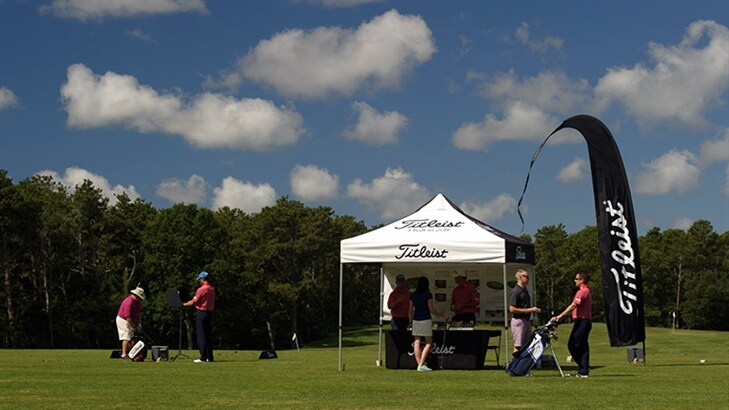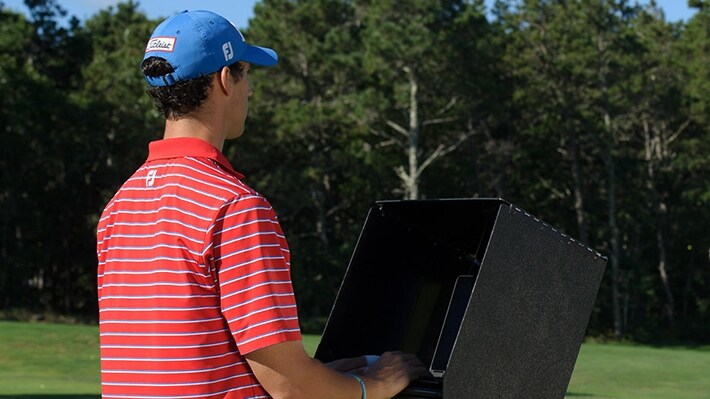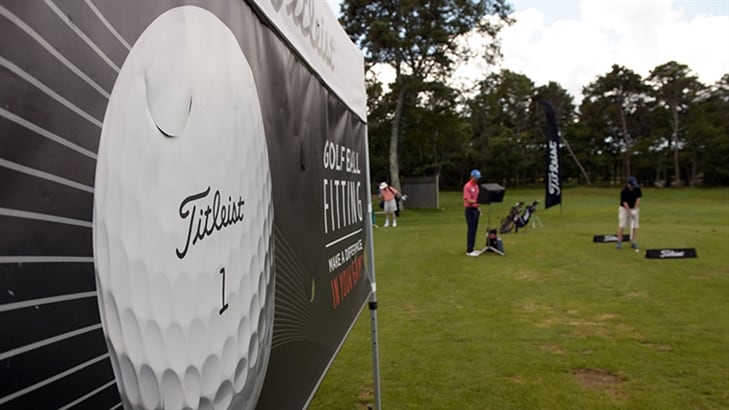
Our Titleist golf ball fitting vans reach tens of thousands of golfers each year at our fitting events across the nation. But how exactly do we help golfers find the right Titleist for their game?
To answer that question, we recently went to a golf ball fitting event and followed along with one of our fitting experts, Patrick Dewar, as he worked with Lou, a longtime Pro V1 player.
When we first spoke with Lou he was eager to gain a better understanding of the differences between Titleist golf ball models and he also wanted to ensure he was playing the right golf ball for his game.
With this in mind, Patrick and Lou got to work and here is how the session unfolded.
Step 1: Game Assessment and Golf Ball Selection
Every fitting begins with an assessment of a player’s game, his or her performance objectives, and his or her personal preferences. Our goal in golf ball fittings is always the same: help golfers play better and shoot lower scores.
When discussing the specifics of his game with Patrick, Lou noted that he loves the feel and control of Pro V1 around the greens, but he wanted to know if other Titleist models might provide performance advantages off the tee and on his approach shots into greens.
After taking a deep dive into Lou’s game, discussing topics such as short game spin and control, ball flight, and feel preferences, it was time to hit some shots and capture some numbers using a TrackMan launch monitor.
To establish a baseline for the fitting, Lou hit a few 50-yard wedge shots, 6-irons and drivers using Pro V1 golf balls
Since Lou wanted to see the differences in golf ball models, Patrick had him hit some 50-yard wedge shots with Pro V1 and then some shots with Velocity. He immediately noted the softer feel of Pro V1 and the more penetrating trajectory compared to the firmer feel and noticeably higher trajectory with Velocity. And the numbers on TrackMan confirmed what Lou was seeing - Velocity launched significantly higher than Pro V1 and spun up to 2,000 RPMs less.

Patrick then had Lou hit 6-iron shots, which he hit at a 13-degree launch angle and 37-degree land angle. Lou said he hit both solid, but wished he hit his mid and long irons higher so he could have an easier time getting those shots to stop on the green.
“Ideally we want to see players launching their 6 iron around 17 degrees with a land angle around 46 degrees,” Patrick said. Patrick then had Lou hit a couple more 6-irons, but (without telling Lou) Patrick swapped out a Pro V1 golf ball for a Pro V1x golf ball, which is engineered to have a higher trajectory than Pro V1.
This was all it took to notice an immediate change to Lou’s ball flight. With Pro V1x, Lou’s launch angle increased by 2 degrees and his land angle increased by 4 degrees. With the optimized launch and land angles, Lou was starting to see how this could potentially help his approach shots stop on the green.
Moving on to the driver, Lou shared that he wasn’t “getting enough out of his driver,” primarily due to his low ball flight. Lou’s spin rate with his driver was a little higher than desired and his launch angle was lower. Patrick again had Lou hit some Pro V1x golf balls, and with Pro V1x, Lou’s launch angle increased, his spin decreased and he saw a 14-yard increase in carry distance.
Due to Lou’s initial launch conditions, he was able to pick up additional distance with his driver by lowering spin and increasing launch. It is important to note that every golfer’s launch conditions are different, and the only way to know which golf ball will perform best for you is to go get fit like Lou did.
Based upon the assessment and TrackMan analysis, Patrick recommended Pro V1x for Lou to provide similar feel, control and stopping power in the short game to the Pro V1, as well as increased distance off the tee.
Step 2: On-Course Green-to-Tee Evaluation
With the potential models narrowed down, Patrick provided Lou with samples of Pro V1 and Pro V1x golf balls and took a couple minutes to talk through the steps of the on-course green-to-tee evaluation. Comparing golf balls side by side on a variety of shots is the best way to experience the performance differences between models.
“Go out on the course and evaluate the golf balls on a variety of short game shots, then move back and hit some half and full wedges, then some short and mid iron approach shots, followed by some hybrids and fairway metals. Finally, finish up with some drivers.”

Step 3: Putting the new ball in play
The final piece of advice Patrick gave Lou is the importance of using the same model golf ball for every shot of every round. “Once you go through the green-to-tee process to confirm which model is best for you, stick with it and use it every time you play,” Patrick explained.
“Committing to one model and playing it consistently, eliminates performance variation, builds confidence and consistency, and ultimately results in shooting lower scores.”
Check back soon as we plan to share more golf ball fitting stories from our team of experts, and in the meantime, click here for more information on golf ball fittings.